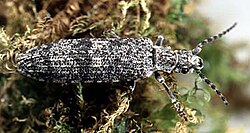| Priacma Temporal range: | |
|---|---|
 | |
| Priacma serrata | |
| Scientific classification | |
| Domain: | Eukaryota |
| Kingdom: | Animalia |
| Phylum: | Arthropoda |
| Class: | Insecta |
| Order: | Coleoptera |
| Family: | Cupedidae |
| Genus: | Priacma LeConte, 1874 |
| Type species | |
| Cupes serrata LeConte, 1861 | |
| Species | |
| |
Priacma is a genus of beetles in the family Cupedidae. It contains a single extant species, Priacma serrata native to western North America [1] and one fossil species, P. megapuncta from the Cenomanian aged Burmese amber. [2] Species previously assigned to the genus from the Yixian Formation of China [3] have been subsequently placed in the separate genus Apriacma . [4]